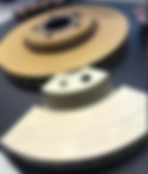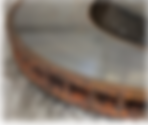Bespoke, Customisable Discs



Background
The UK is home to a large and diverse car culture, with enthusiasts of all types of vehicles, from classic cars, to sports cars to modified cars, across multiple levels of dedication. According to a recent study, around 40% of adults in the UK are considered car enthusiasts, meaning that they have a strong interest in cars and enjoy reading about and talking about them. When making purchases, car enthusiasts are often driven by particular motivations:
-
Performance enhancements: Many car enthusiasts enjoy the thrill of driving a high-performance vehicle and are willing to spend money to upgrade their car's engine, suspension, braking system, and other components to improve performance and handling.
-
Aesthetics: Car enthusiasts often want their vehicles to look as good as they perform. They may spend money on custom paint jobs, body kits, wheels, and other visual upgrades to make their cars stand out.
-
Personal expression: Many car enthusiasts see their vehicles as a form of self-expression. They may customise their cars to reflect their personal style and preferences.
-
Investment: Some car enthusiasts see their vehicles as investments. They may purchase classic or rare vehicles with the intention of preserving or restoring them, and then selling them for a profit.
-
Passion: For many car enthusiasts, working on and modifying cars is a passion. They enjoy the process of researching, acquiring, and installing parts and modifications, and the satisfaction of seeing the finished product.
-
Sense of community: Car enthusiasts often enjoy sharing their passion with others. They may spend money on car shows, events, and car clubs to connect with other like-minded individuals and share their enthusiasm for cars.
Issue

Despite this passion and investment, we are still repeatedly seeing an issue in the market - a lack of high performance brake discs that look and perform well, always.
Car enthusiasts are finding that their brake discs wear out quickly and need to be replaced frequently. They are experiencing issues such as warping or cracking, which can cause vibration or pulsation when braking. Additionally, their brake discs are not be able to handle the high temperatures generated by high-performance driving, leading to fading or reduced braking effectiveness. These issues can be costly to repair and often require frequent replacement of so called 'durable, high-performance brake discs'.
In addition to the issues mentioned above, expensive car owners are also experiencing problems with corrosion on their brake discs. Corrosion can occur when brake dust, road salt, and other environmental factors come into contact with the discs, causing them to rust or become corroded. This can lead to reduced braking effectiveness, uneven wear, and even complete failure of the brake system. Additionally, corrosion can also make it difficult to remove the brake pads from the disc, further exacerbating the problem. To prevent corrosion, car owners currently need to clean and maintain their brake discs regularly and take extra care when driving in areas with high levels of road salt or other corrosive substances.
This is a noticeable issue when expensive vehicles are stored away for extended periods of time, over winter for example. Expensive car owners are finding that, due to not being used, when their vehicles are taken out of storage the discs are completely corroded, looking unappealing and often requiring replacement. Currently, these owners are having to clean and coat brake discs with a rust inhibitor before storing them to reduce the effects of this, as well as storing vehicles in a dry, climate controlled environment to prevent moisture accumulating on the disc, which is not always possible.
Don't worry, this isn't the way it has to be!
Solution




We are offering PVD (Physical Vapor Deposition) and LMD (Laser Metal Deposition) coatings which are cutting-edge technologies that are applied to brake discs to provide a range of benefits, including improved performance (making them more effective and reliable), longer lifespan (reducing the need for frequent replacements), 60% reduction in brake dust pollution and enhanced aesthetics to really make your vehicle stand out!
What does this mean for you?
-
Increased durability: PVD & LMD coatings are harder and more durable than traditional coatings, making them less susceptible to wear and tear, and providing better resistance to corrosion.
-
Improved thermal performance: PVD & LMD coatings can help to dissipate heat more effectively, which can reduce brake fade and improve overall braking performance, especially under high-performance driving conditions.
-
Enhanced aesthetics: PVD & LMD coatings can be used to create a variety of different colors and finishes, which can enhance the appearance of the brake discs and make them more visually appealing.
-
Cost-effective: PVD & LMD coating can be applied in a cost-effective way. The coatings are very thin and lightweight, which makes them a good option for high-performance brake discs.
-
Improved performance in wet conditions: PVD & LMD coatings can help to prevent rust and corrosion, which can improve the performance of the brake discs in wet conditions.
Visual Appearance of the Disc
PVD Coating
With PVD coating the complete disc is coated in your choice of colour!
Colours Offered:
-
Pink
-
Orange
-
Brown
-
Light Gold
-
Black
-
Gold
-
Silver
LMD Coating
LMD coating is used on the friction surface of the disc, the rest of the disc is coated with long term corrosion protection in your choice of colour!
Colours offered:
-
Yellow
-
Orange
-
Red
-
Blue
-
Grey
-
Silver
-
Black





Engravings can also be applied to the disc!

Improved Lifecycle and Reduced Brake Dust Emissions
The PVD & LMD coatings lead to huge improvements in brake performance, a 60% reduction in brake dust emission production and large savings in long run costs due to replacing the brake discs less frequently.
To measure the enhanced benefits of LMD & PVD coating we ran a standard test to measure the wear of the disc after 80,000km. The results of the test showed the following wear in (mm) for both the conventional and standard discs:
-
Brake Disc Front Axel: The conventional disc had a wear of 0.4mm while our disc had a wear of 0.02mm
-
Brake Disc Rear Axel: The conventional disc had a wear of 0.34mm while our disc had a wear of 0.01mm
-
Brake Pad Front Axel: The conventional disc had a wear of 8.2mm while our disc had a wear of 4.4mm
-
Brake Pad Rear Axel: The conventional disc had a wear of 5.8mm while our disc had a wear of 2.6mm
The results clearly showed how our PVD & LMD coatings reduce the wear of both the brake disc and the brake pads. The brake pads lasted 2x longer than with conventional brake discs, although this will be dependent on the choice of brake pad, and the brake discs lasted 27x Longer on average! However we recommend that brake discs should be changed, at the latest, every 6 years!
Corrosion Elimination
Our solution eliminates the corrosion behaviour of the brake disc at the friction surface, the ventilation channel and also the pot!
We tested this using a standard endurance test from Audi across 15,000km with our brake discs on the left hand side of the car and conventional discs on the right hand side. Following this test, it was clear to see how our disc showed no sign of corrosion at all while the conventional disc was heavily corroded as expected!




Influence to the Wheels
While the brake pad wear eventually causes defilement to the rims and wheels of the vehicle, the use of our PVD & LMD coating keeps the appearance of your vehicle much cleaner for much longer.
We tested this across 50,000km and while the rims and wheels of the vehicle with conventional discs was visibly dirty, these remained clean over the same distance when replaced with our discs!


Homologation
Each individual brake disc and dedicated brake pad needs an ECE R90 approval which makes it safe and legal for road use. We provide these certifications for each of the brake discs we sell.
The Technical Part!
LMD Coating
LMD coating, also known as laser cladding, is a process where a laser is used to melt and fuse a metal powder onto the surface of the brake disc, creating a very dense and consistent coating. LMD coating is known for its exceptional wear resistance, corrosion resistance, and heat dissipation properties. This process creates a more consistent and uniform coating, which makes it suitable for high-performance and track use.
The focus of our LMD development is to reduce the wear of the friction couple. Reducing the wear of the friction couple provides multiple benefits including reduction of particulate matter emissions and better wear resistance of the disc, which means it lasts longer. Our specific type of LMD coating is exclusive to our supplier, who have a patent for this development. This means that the technical benefits shown above are specific to us!
Our solution provides a single layer of LMD coating which consists of a uniquely developed composition. In order to apply a mono layer, a specific powder mix is used and the elements in the mix, combined with the temperature of the cladding process, convert the carbon in the rotor into hard phases. As a result the use of carbides can be avoided which means there is no longer a need to use grinding for the final machining process.
LTCP Coating (Aludur)
Alongside the LMD coating which is placed on the friction surface, we additionally coat the rest of the disc with a long term corrosion protection (LTCP) which is particularly important due to the longer lifetime of our discs! This is a technical process which involves first blasting the friction surfaces that needs to be coated. Next, the LTCP coating is applied either by arc wire spraying or dipping, depending on which individual surfaces are selected for coating. Finally, the disc receives heat treatment and the friction surfaces are machined.
During the coating process, all surfaces of the brake rotor, with the exception of the contact surfaces (Rim - Wheel hub) are coated. During the temperature process a diffusion of around 0.3mm takes place on all coated surfaces. This ensures that even difficult to access areas (E.g. ventilation channels) are coated.
The diagram below identifies the four main surfaces of a brake disc. LTCP protection is applied to surface A, B & C and LMD coating is applied to surface B & C.

PVD Coating
PVD coating is a process where a thin layer of metal is deposited onto the surface of a brake disc using a high-vacuum process. PVD is characterized by a process in which the material transitions from a condensed phase to a vapor phase and then back to a thin film condensed phase. The most common PVD processes are sputtering and evaporation. This coating provides several benefits, including improved wear resistance, better heat dissipation, and increased resistance to corrosion. The PVD coating is extremely durable and can withstand high temperatures, making it an ideal option for high-performance cars and track use.
With PVD multiple colours can applied to discs. The disc itself is completely coated and the coating is similar to the hard coating created by LMD (laser cladding).
Brake Pads
PVD & LMD coatings require the use of different brake pads to achieve the same benefits. Brake pad type P must be paired with PVD coating and brake pad L must be paired with LMD coating. The brake pad qualities are in house developments from our supplier and will be provided alongside the brake discs. The brake pads have a ECE R90 approval which makes them safe and legal for road use.
To make an order or find our more please contact us directly!
Flat 11, 84 Elm Grove
Portsmouth
PO5 1LN
E-Mail: DAEnterprises1702@gmail.com